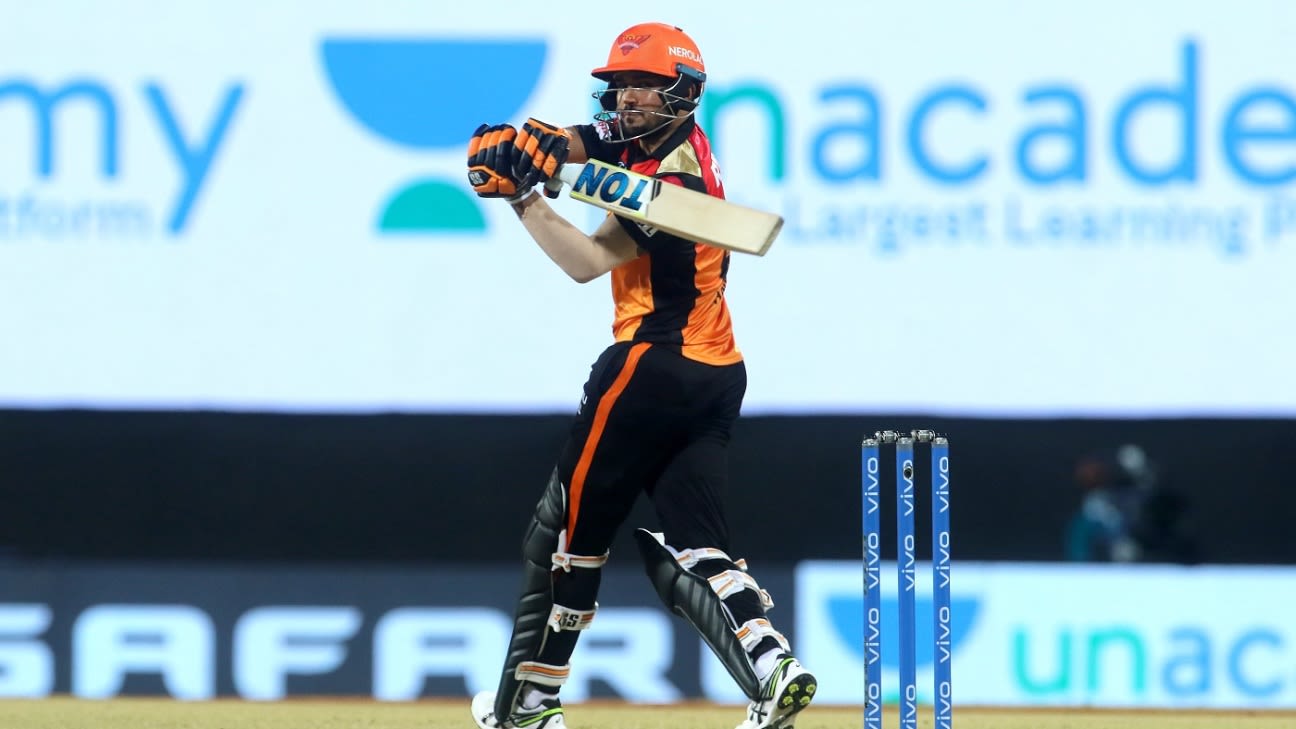And how did Holder end with 3 for 30 on a pitch that was slow and sluggish?
Here are the major Talking Points after Royal Challengers Bangalore’s six-run win against the Sunrisers Hyderabad on Wednesday.
Are Manish Pandey’s runs hurting the Sunrisers?
With 99 runs, Manish Pandey is the leading run-scorer for the Sunrisers Hyderabad at the moment but with a strike rate of 119.27. For someone who faced 83 deliveries across two games, are Pandey’s runs hurting his side more than helping them?
Chasing 188 against the Kolkata Knight Riders, Pandey finished with an unbeaten 61 off 44 balls. According to ESPNcricinfo’s smart stats, which take into account the match situation, his 61 was worth only 56. It was a similar story on Wednesday. The target was 150 but Pandey crawled along for 38 off 39 balls. His smart runs were 34.
The problem with Pandey is even after being set, he fails to kick on. Shiva Jayaraman from our stats team dug out these numbers: in the last three IPL seasons, 25 batsmen have played ten or more innings where they faced 25-plus balls. Pandey’s strike rate of 136.24 after facing 25 balls is the second-worst among them. Only Chris Lynn (129.54) is below him.
Pandey’s dot-ball percentage though isn’t bad, which means he simply struggles to find boundaries. On average, Pandey takes 7.9 balls per boundary after 25 balls, the most in that lot of 25. It’s possible Pandey may have been assigned the role of the anchor, but such a low strike rate, especially after facing so many deliveries, isn’t helping his team’s cause.
Why was Harshal allowed to continue after bowling two waist-high full tosses?
In the 18th over of the Sunrisers’ innings, Harshal Patel bowled a leg-side full toss to Jason Holder, which was called a no-ball for height. In the final over, he bowled another such delivery to Rashid Khan. That too was given a no-ball. But Patel was allowed to continue.
The reason being the on-field umpires didn’t deem at least one of those deliveries not dangerous. The law states that only if a bowler delivers two dangerous deliveries, not necessarily two waist-high full tosses, can he be suspended from bowling further in the innings. While deciding whether a delivery is dangerous or not, the umpires also keep in mind the speed, height and direction of the delivery, and the skill of the striker. Trevor Bayliss, the Sunrisers coach, also agreed with the umpires, saying the first one was not really directed at the batsman.
How did Holder use the slow Chepauk pitch to his advantage?
The MA Chidambaram Stadium surface is known to be slow, sluggish and helpful for spinners. On Tuesday, the Knight Riders bowled spin for the first five overs against the Mumbai Indians. That though also had a bit to do with Rohit Sharma and Quinton de Kock’s lower strike rates against spin. Still, since 2018, spinners have fared much better in Chennai than seamers. They have a better average (20.74 vs 29.10) and a better economy rate (6.47 vs 8.47).
So far this season, the ball hasn’t swung much in Chennai. During the pitch report, Murali Kartik called Wednesday’s pitch “the driest” of the lot. Still, Holder finished with figures of 3 for 30 from his four overs. How did he do it?
The answer is by banging it in the middle of the pitch and taking the pace off. Seventeen of Holder’s deliveries were either short or short of good length; and only 15 runs came off them. Bhuvneshwar Kumar, who is a swing bowler and normally bowls fuller, also bowled similar lengths. Out of his 24 deliveries, only two were full, while 11 were either short or short of good length. Off those 11 deliveries, he conceded just six.
Why did Shahbaz Ahmed bat at No. 3?
Shahbaz Ahmed had played 24 T20s coming into this game and had never batted higher than No. 5. But Virat Kohli stated at the toss itself that Ahmed would be batting at No. 3.
Over the years, the Royal Challengers have been too top-heavy and been found wanting in case of early wickets. While they have got Glenn Maxwell, alongside AB de Villiers, to shore up the middle order this time, they probably want to ensure the two don’t come in too early. That’s why in the first game they had Rajat Patidar batting at No. 3.
Now with Devdutt Padikkal fit, there was no place for Patidar. So the Royal Challengers went with Ahmed, who was aggressive right from the start, allowing Kohli to take his time at the other end. He managed 14 off ten and fell on the first ball of the seventh over. Did the move work? It might just have because you don’t want to keep two of your best batsmen out of action for too long.
Hemant Brar is a sub-editor at ESPNcricinfo
